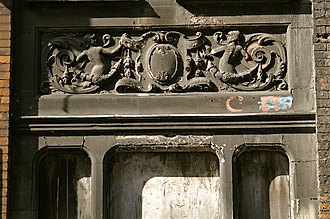Slaughterhouse: Difference between revisions
CSV import |
CSV import |
||
| Line 48: | Line 48: | ||
[[Category:Environmental impact of agriculture]] | [[Category:Environmental impact of agriculture]] | ||
[[Category:Animal rights]] | [[Category:Animal rights]] | ||
== Slaughterhouse == | |||
<gallery> | |||
File:Hoisting a slaughtered steer in Benjamin Lutz's slaughterhouse 8d23516v.jpg|Hoisting a slaughtered steer in Benjamin Lutz's slaughterhouse | |||
File:Lovis Corinth Im Schlachthaus.jpg|Lovis Corinth Im Schlachthaus | |||
File:Smithfield Last day of Old Smithfield ILN 1855.jpg|Smithfield Last day of Old Smithfield ILN 1855 | |||
File:Fish market smithfield.jpg|Fish market smithfield | |||
File:Richardson's abattoir.jpg|Richardson's abattoir | |||
File:Solid Wastes from Slaughterhouse.jpg|Solid Wastes from Slaughterhouse | |||
File:Atria slaughterhouse in Nurmo Seinajoki.JPG|Atria slaughterhouse in Nurmo Seinajoki | |||
File:Swine inspection USDA.jpg|Swine inspection USDA | |||
</gallery> | |||
Latest revision as of 01:11, 20 February 2025





== Slaughterhouse ==
A slaughterhouse, also known as an abattoir, is a facility where animals are processed for consumption as food products. These facilities are integral to the meat industry and are designed to handle the slaughtering and processing of various types of livestock, including cattle, pigs, sheep, and poultry.
History[edit]
The history of slaughterhouses dates back to ancient civilizations where animals were killed and processed in open markets. The industrial revolution brought significant changes, leading to the establishment of more organized and sanitary slaughterhouses. The development of refrigeration and transportation technologies further revolutionized the industry, allowing meat products to be distributed over long distances.
Process[edit]
The slaughtering process typically involves several stages:
- Stunning: Animals are rendered unconscious to minimize suffering. Methods include electrical stunning, captive bolt stunning, and gas stunning.
- Bleeding: The unconscious animal is then bled by severing major blood vessels.
- Skinning and Evisceration: The hide is removed, and internal organs are extracted.
- Carcass Processing: The carcass is divided into primal cuts and further processed into retail cuts.
Regulations[edit]
Slaughterhouses are subject to strict regulations to ensure humane treatment of animals and food safety. In the United States, the United States Department of Agriculture (USDA) oversees these facilities, enforcing the Humane Methods of Slaughter Act and the Federal Meat Inspection Act. Similar regulatory bodies exist in other countries, such as the Food Standards Agency in the United Kingdom.
Environmental Impact[edit]
Slaughterhouses have a significant environmental impact, contributing to water pollution, air pollution, and greenhouse gas emissions. Efforts to mitigate these impacts include waste treatment systems, renewable energy use, and sustainable practices.
Ethical Considerations[edit]
The ethical treatment of animals in slaughterhouses is a major concern. Organizations such as PETA and the Humane Society advocate for better welfare standards and promote vegetarianism and veganism as alternatives to meat consumption.
Related Pages[edit]
- Meat industry
- Animal welfare
- Food safety
- Humane Methods of Slaughter Act
- Federal Meat Inspection Act
- Vegetarianism
- Veganism
See Also[edit]
| Meat industry | ||||||||||
|---|---|---|---|---|---|---|---|---|---|---|
This meat industry related article is a stub.
|
| Food safety |
|---|
 |
| Terms |
| Critical factors |
| Bacterial pathogens |
| Viral pathogens |
| Parasitic pathogens |
Slaughterhouse[edit]
-
Hoisting a slaughtered steer in Benjamin Lutz's slaughterhouse
-
Lovis Corinth Im Schlachthaus
-
Smithfield Last day of Old Smithfield ILN 1855
-
Fish market smithfield
-
Richardson's abattoir
-
Solid Wastes from Slaughterhouse
-
Atria slaughterhouse in Nurmo Seinajoki
-
Swine inspection USDA







